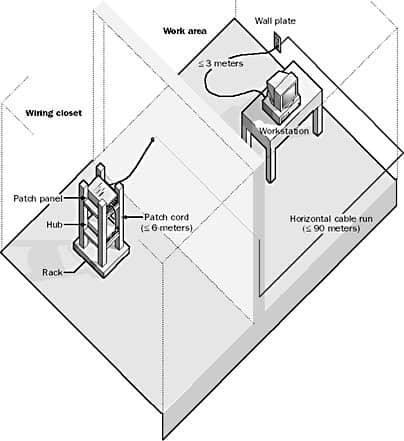Horizontal Cabling, in premise cabling, is any cabling that is used to connect a floor’s wiring closet to wall plates in the work areas to provide local area network (LAN) drops for connecting users computers to the network.
What is Horizontal Cabling?
Horizontal Cabling is any cabling that is used to connect a floor’s wiring closet to wall plates in the work areas to provide local area network (LAN) drops for connecting users’ computers to the network.
Horizontal cabling is most easily installed during construction or renovation of the building because proper installation might require opening false ceilings or walls. If this is not feasible, installing external cable trays and conduits might be the best solution, because loose cables on the floor pose a hazard and should be avoided at all costs.
Horizontal cabling is usually installed in a star topology that connects each work area to the wiring closet, as shown in the illustration. Four-pair 100-ohm unshielded twisted-pair (UTP) cabling (category 5 cabling or enhanced category 5 cabling) is usually recommended for new installations because it supports both voice and high-speed data transmission. To comply with EIA/TIA wiring standards, individual cables should be limited to 90 meters in length between the wall plate in the work area and the patch panels in the wiring closet. Patch cords for connecting the patch panel to hubs and switches in the wiring closet should be no longer than 7 meters total distance (with a maximum of two patch cords per line, each of which does not exceed 6 meters in length). Cables connecting users’ computers to wall plates should be limited to 3 meters in length.
Avoid EMI
Avoid installing cables near motors, generators, transformers, or power lines in order to minimize electromagnetic interference (EMI). Keep cables away from photocopying machines and elevators because these machines generate a lot of EMI.
If you anticipate increased bandwidth needs in the near future, use multimode fiber-optic cabling instead of UTP cabling for horizontal cabling.
You probably want to install two four-pair UTP cables in each work area, one for voice and the other for data transmission. Be sure to use the right kind of wall plates (RJ-11 for voice and RJ-45 for data).
